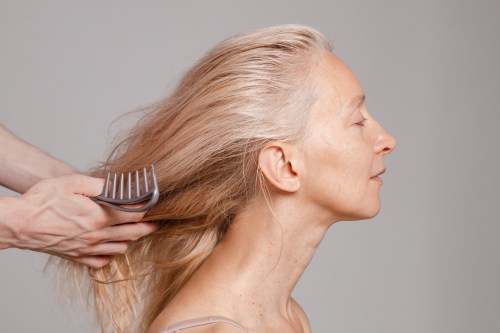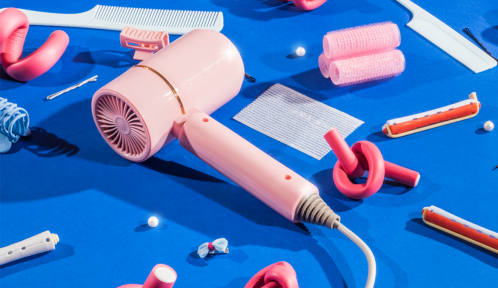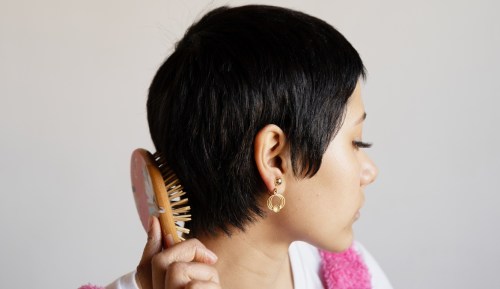Hair is a pretty big deal; a simple refresh with a new cut or maybe color can transform your entire mood. But many people experience dramatic hair loss that strips them of this luxury. For a variety of reasons—cancer treatments, alopecia, burns, and more—these individuals can be left without one of their most defining features. Wigs can be the best option for those in this situation who want to feel like themselves again, but the good ones tend to be expensive—too expensive, in many cases.
Experts in This Article
Suzanne Chimera is a cosmetologist and the co-founder of Hair We Share, an organization which collects donated hair to make wigs for those struggling with medical hair loss.
This was difficult for Suzanne Chimera to stomach as a long-time employee at Manny Robert’s Hair Replacement in New York. “Each time I consulted with a person who was going through hair loss, I felt like I died a little on the inside when it came to charging them—especially if it was a child,” says Chimera, co-founder of Hair We Share. “The expense is a burden, adding insult to injury.” Chimera was particularly moved by a 13-year-old girl struggling with alopecia universalis, which results in total hair loss (head and body), and had left school due to bullying. The teenager had seen an actress share her own battle with the condition and become fixated on obtaining a wig like the one she’d see her wear; however, such wigs can cost $3,600 or more.
So, Chimera turned to Facebook to ask for hair donations so she could create a wig free of charge to the teenager. “What I didn’t expect was the sense of community we created, not only for Brooke but for the hair donors we chose to use for Brooke’s wig,” she says. “They saw their donation make a difference.”
Thus began Hair We Share which, like other hair donation organizations, utilizes gifted locks to make gorgeous wigs accessible to those suffering from medical hair loss. Chimera says they’ve helped any and every kind of client, including those who are victims of hair loss due to domestic violence and, most recently, COVID-19. (COVID-19 infection can cause hair loss for some—actress and activist Alyssa Milano, for example, shared her struggles with COVID-related hair loss on Instagram.)
It’s pretty easy to help out by donating your own no-longer-needed length, but there are a few things you need to know before making the chop; find out how to donate your hair below.
Specifications for donated hair
Most hair donation organizations accept all natural colors (including gray) and types of hair, with a few exceptions. Hair We Share, for example, cannot accept hair that’s been bleached. “The reason is that bleached hair compromises the interior of the hair,” Chimera says. “[When making wigs], the hair is sewn in a very tight knot (much like a crochet stitch). Bleached hair will break either during this process or worse, shed from the wig as it is worn.” Wigs for Kids, meanwhile, cannot accept any color-treated hair, even if it’s only highlighted. Permed hair isn’t accepted there, either. Locks of Love, however, will accept color-treated hair, although they can’t guarantee it will be deemed viable for wig-making.
Required length likewise varies by organization but in general, it’s significant. Locks of Love requires 10 inches of hair, while Hair We Share and Wigs for Kids both require 12 inches, for example. This is because it takes a lot of hair—sometimes up to five or six donations—to make one wig. “When we make a wig, the hair is folded for sewing,” Chimera exlains. “Each hair becomes two hairs in a wig [which shortens it]. For example, eight inches in the back and sides [of the head] will yield six inches in a wig and only four in the front, top, and hairline. ”
Before chopping, be sure to check the individual specifications regarding color, processing, and length set by your desired donation recipient.
How to prep your hair for donation
Hair should be clean and dry (wet hair will grow mold—ew!). Chimera asks that curly or wavy hair be kept in its natural condition rather than blown straight, but Locks of Love allows for straightened hair in order to meet its 10-inch requirement. Split ends should be trimmed in advance to best determine the donated length.
If you’re planning to donate hair in the future—as opposed to ASAP—you want to make sure you treat it nicely in preparation. This means limiting the use of hot tools and using heat protectants on the hair as well as regularly trimming it to avoid breakage as it grows.
Making the chop
For donations, hair must be secured in rubber bands and cut with one inch above the band, says Chimera. “This is so it stays in the direction of growth,” she says. “If the hairs are reversed from the direction of growth, the cuticles tangle and it becomes unusable.”
If you’ve even seen hair donation depicted on film or TV, you might think you can simply tie your hair into a ponytail and chop; however, this is not the best method for optimizing your gift. Instead, the hair should be divided into several ponytails or braids. “The more ponytails, the more length we get,” says Chimera. “It’s so important. If all the hair is dragged into one ponytail and chopped, only the hair at the base of the ponytail will be the longest. Much of the rest of the hair will be too short. The hair that remains on the donor will need to be cut to even, and the extra length that could have been donated [will instead be] thrown away.”
The best way to divide your hair is to create a center part, and then section off from there. For reference, four ponytails, or braids, is a good number. And if you’re anxious about messing up, most salons are prepped for pro donation cuts.
Shipping your leftover locks
Prior to shipping, hair must be tightly secured so it doesn’t arrive frayed. The best way to do this is to wrap rubber bands around it in several places, about two or three inches apart. Then, seal your ponytail or braid in a Ziploc bag and place it in a sturdy envelope or box. “We have had regular envelopes arrive empty because they go through a roller at the post office and the hair gets ripped out,” says Chimera.
How to help if your hair is too short or processed to donate
Of course, not everyone has a foot of untouched hair to donate, but there is another significant way to help: financial contributions. “It costs us $145 [per wig] from received to recipient,” says Chimera. “We offer hair donors our Ponytail Tracking Program to cover this expense and while it has been catching on, less than 10 percent of the hair we receive gets sponsored by the donors.”
Before 2019, she says, the company was able to make up the difference with fundraising events. Now, however, hair donations exceed fundraising efforts by thousands of dollars.
Giving money can help to offset such disparities and ensure charities like Hair We Share thrive. After all, these charitable products require a significant labor of love. “It takes 50 hours to make one wig,” says Chimera.
Where to donate your hair
- Hair We Share
- Locks of Love
- Wigs for Kids
- Hugs-U-Wear
- Children with Hair Loss
- Angel Hair for Kids
- Wigs and Wishes
- Maggie’s Wigs 4 Kids
- Pink Heart Funds
Oh hi! You look like someone who loves free workouts, discounts for cult-fave wellness brands, and exclusive Well+Good content. Sign up for Well+, our online community of wellness insiders, and unlock your rewards instantly.
Sign Up for Our Daily Newsletter
Get all the latest in wellness, trends, food, fitness, beauty, and more delivered right to your inbox.
Got it, you've been added to our email list.











